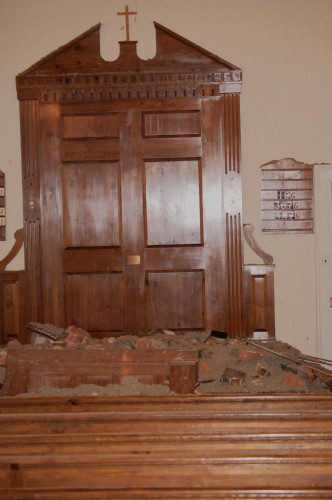 A few weeks ago we had an earthquake here in Virginia. I just found out on Sunday that our bell tower at our church in Alexandria experienced significant structural damage from the quake (my husband thought it would have been cool if the bell itself had cracked -- it didn't).
In any case, the Associated Press reported on one congregation that will have to rebuild its entire sanctuary. Here's how it begins:
A few weeks ago we had an earthquake here in Virginia. I just found out on Sunday that our bell tower at our church in Alexandria experienced significant structural damage from the quake (my husband thought it would have been cool if the bell itself had cracked -- it didn't).
In any case, the Associated Press reported on one congregation that will have to rebuild its entire sanctuary. Here's how it begins:
Members of the tiny congregation of a church rocked by a Virginia-centered earthquake are launching a fund-drive to restore their sanctuary.
The 5.8-magnitude quake Aug. 23 rocked the Gilboa Christian Church in Cuckoo, which is located near the epicenter of the quake in Mineral. The church dates to 1857 and has between 50 and 75 members.
“It’s just heartbreaking,” Peggy Albright, who has attended services at the church for nearly 80 years, told The Daily Progress of Charlottesville.
Church members agreed to raise an estimated $350,000 to restore the church, which suffered structural damage. The congregation was to meet at a nearby community center Sunday to worship.
It couldn't be a more straightforward story but what struck me was that a congregation with as many as 75 members would be described as "tiny." I'm not entirely sure how many members my congregation has but I'd guess it's somewhere between 200 and 300 members. I never know how to describe this size -- is that small? Is it medium? I know it's not a megachurch, but other than that, I'm not sure what the relative size is.
I know I'm not alone because I hear people all the time say that their congregational size is small. But I remember reading that the typical congregation is actually much smaller than people realize. I found Hartford Seminary's Hartford Institute for Religion Research had something that might help:

Q: What’s the size of U.S. churches? A: The median church in the U.S. has 75 regular participants in worship on Sunday mornings, according to the National Congregations Study http://www.soc.duke.edu/natcong/ . Notice that researchers measured the median church size — the point at which half the churches are smaller and half the churches are larger — rather than the average (186 attenders reported by the USCLS survey http://www.uscongregations.org/charact-cong.htm ), which is larger due to the influence of very large churches. But while the United States has a large number of very small churches, most people attend larger churches. The National Congregations Study estimated that the smaller churches draw only 11 percent of those who attend worship. Meanwhile, 50 percent of churchgoers attended the largest 10% of congregations (350 regular participants and up). Want to know more? Check the websites for the National Congregations Study at http://www.soc.duke.edu/natcong/ The US Congregational Life Survey (USCLS) website has statistics about congregations by religious traditions at http://www.uscongregations.org/
I'm not sure how many of the members of the church in question are active participants, and no one would argue that a congregation with as many as 75 members is huge or anything. But I still wonder if we don't have a problem of imagining that the average or median church size is much larger than it is. I have friends who are members of congregations plenty smaller than the one in question. How should their congregational size be described? Teensie? I also wonder if our perceptions -- rather than statistical analysis -- doesn't affect media coverage of congregations. Do journalists think that the typical congregation is much larger than it is?
In the case you're interested, I've included a graph from the Hartford Institute for Religion Research that shows the breakdown. And the picture above is from the congregation's Facebook page.
